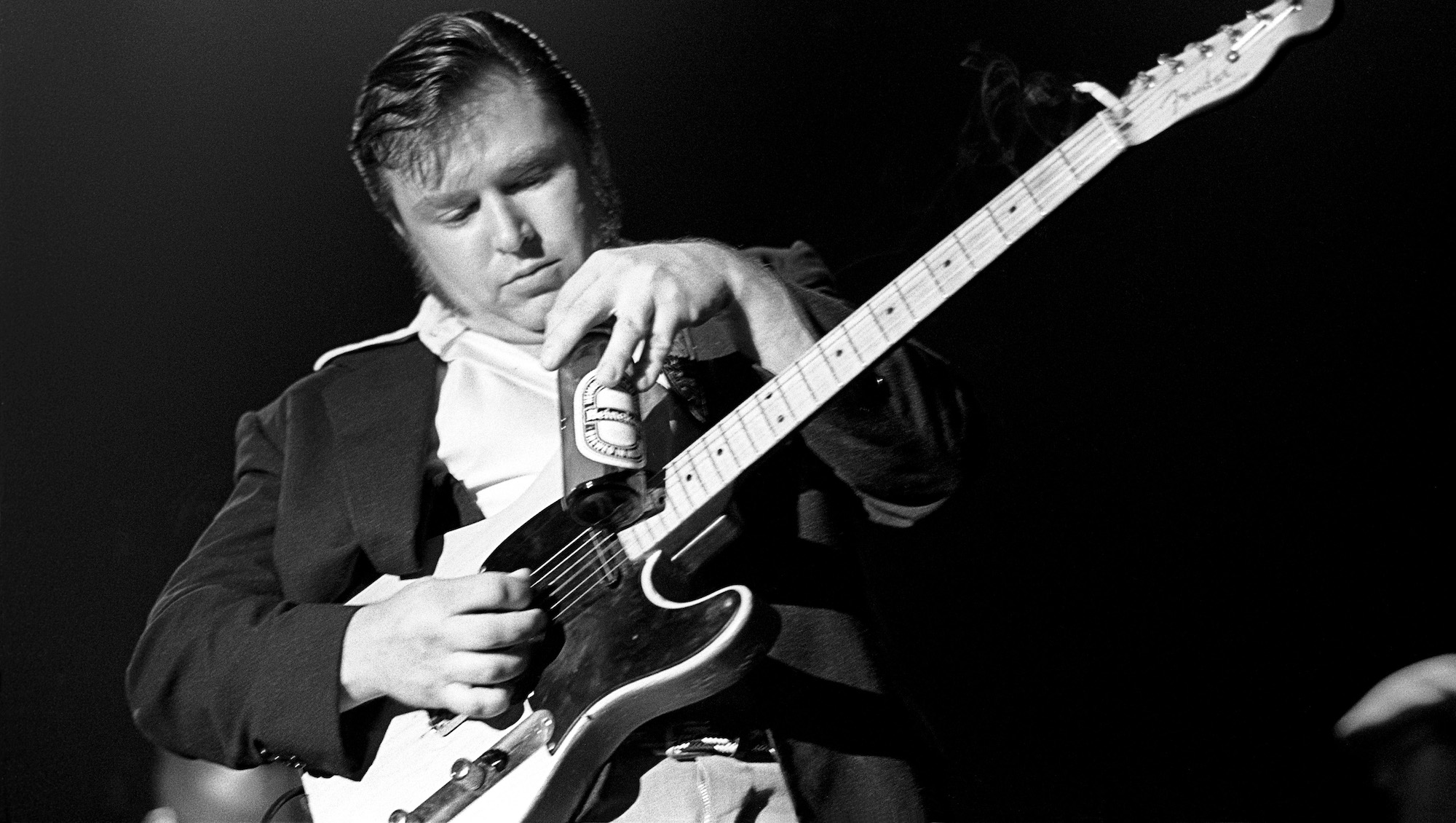Kim Thayil picks Soundgarden’s landmark guitar moments
In honor of the grunge icons’ Rock and Roll Hall of Fame nomination, their lead guitarist picks the standout songs on which he and Chris Cornell made their case for Seattle’s most daring guitar exports

“When it comes to Soundgarden, we didn’t bend too far towards radio-friendly,” Kim Thayil says. Nevertheless, the guitarist continues, “We did end up being radio-friendly, even with our weird tunings.”
Indeed, over the course of their career, the Seattle giants not only pioneered many of the elements of the sound that would eventually become known throughout the world as grunge, but also managed, courtesy of a highly developed and often idiosyncratic songwriting and guitar approach, to bring that sound straight into the center of mainstream culture, racking up platinum albums (among them 1991’s Badmotorfinger and 1994’s Superunknown) and monster radio and MTV hits (Outshined, Black Hole Sun, Spoonman), as well as influencing scores of rock and alternative bands that followed in their wake.
Now, Soundgarden has, very deservedly, received a nomination for the 2023 Rock & Roll Hall of Fame, their second time on the ballot. And while their long legacy is set in stone, guitarist Kim Thayil says that it would still be a great honor to be inducted this year.
“When I first heard about the Rock & Roll Hall of Fame, I thought, How do you quantify that?” Thayil says.
“But then I started hearing from friends who either were inducted or attended events, and they said, ‘Man, this is fun because of the enthusiasm the fans have for seeing a band they love and believe in having their achievements and merits recognized.’ If you’re a fan, it’s a validation of your choices and your appraisals in your musical tastes. So that changed my understanding of it, and made me realize it’s important.”
Thayil continues, “And now that Chris is gone [Soundgarden singer, co-guitarist and co-songwriter Chris Cornell passed away in 2017 at the age of 52], it’s even more important. It’s for Chris’s memory and the band’s legacy. And for our fans – for the love and commitment they’ve shown us for all these decades.”
In recognition of Soundgarden’s Hall of Fame-worthy career (you can vote for the band to be inducted here), Guitar World sat down with Thayil for a look back at the six-string moments that he believes helped to establish and cement the band’s singular and one-of-a-kind sound.
Get The Pick Newsletter
All the latest guitar news, interviews, lessons, reviews, deals and more, direct to your inbox!
1. Hunted Down (Screaming Life, 1987)
“There's two things that come out of Screaming Life. And the first is the guitar solo in Hunted Down, which pretty much set the tone that there’s going to be some noise elements, some jazz elements, some aspect of cacophony and spontaneity that is going to be incorporated into the way I'm approaching some of our guitar solos.
“With that solo being kind of angular and slashing, I enjoyed how that fit in what would have otherwise been a short, riff-oriented, hard-rock pop song. It showed that our sensibilities were leaning a little bit toward some noisier and artier considerations.”
2. Nothing to Say (Screaming Life, 1987)
“The second Screaming Life example is Nothing to Say, which was the first song we wrote in drop D tuning. But it also exemplifies another aspect of Soundgarden, which is the heavy, drone-y, trippy riff that's contrasted with a more lullaby sort of nursery rhyme-ish, psychedelic thing in the verse, which we're playing up by the 12th fret.
“And then even another thing is the fact that we're incorporating extraneous sounds and noise from the guitar other than traditional fretted chords and scales. This is exemplified by the part where I'm playing the behind the bridge, between the bridge and the tailpiece, on the low E string, and getting a sort of harmonic effect. You'll see that turn up in other songs in Soundgarden's career.”
3. Flower (Ultramega OK, 1989)
“This is perhaps not a significant component to Soundgarden's song style or guitar style, but it was a unique one – and that’s the intro to Flower. Flower, by the way, is the second song we wrote in drop D, and it is the one single off of Ultramega OK. And the intro is me blowing across the strings.
“I’m playing my Guild S-100, and I’m using the bridge pickup setting, which is a little bit brighter. I've dropped the E string down to D, so there's gonna be some sympathetic resonance between the two D strings and the fifth string, the A.
“The Guild has these microphonic pickups, so I can blow over the string and get this sort of sitar-like, sort of ambient effect. And it’s augmented by my use of a chorus pedal. I did that on the record, although it was a kind of a tough thing to pull off live without the guitar screeching or feeding back. And when I did do it live, it never failed to get reviewed as me playing guitar with my beard. [laughs] And I get it: Brown guy. Beard. Guitar. Guitar near face. Playing guitar with beard. No, I'm just too lazy to shave.”
4. Heretic (Deep Six compilation, 1986)
“Heretic was off the Deep Six album, which was not the first Soundgarden release, but it was the first recorded material that we released. It was a song we wrote early on, probably within the first few months of being a band, and it was a regular part of our set in ‘85, ‘86, ‘87.
“We must have released three versions: there's the Deep Six version with drummer Scott Sundquist, a B-side to Loud Love that we recorded with [producers] Steve Fisk and Terry Date, and another version we recorded with Jack Endino.
“But all of these versions, to varying degrees, would emphasize that the guitar part incorporated three or four harmonics into the melody of the riff. And that was something that we would go on to utilize in, for instance, the song Limo Wreck, which Matt [Cameron, drums] wrote with harmonics. Chris incorporated some harmonics into The Day I Tried to Live. The ‘C’ section of Never The Machine Forever has harmonics.
“Now, we weren't the first band to incorporate harmonics into the actual musical riff. But it was definitely part of our style and identity. I think prior to that, people usually used harmonics in guitar solos, as an accent or a color part. But we very consciously used it as the musical head of the guitar riff.”
5. Tears to Forget (Deep Six compilation, 1986; Screaming Life, 1987)
“Also on Deep Six was the song Tears to Forget, which is a hardcore song that had two elements that I think distinguished it as being stylistically Soundgarden. One is the open-string drone. I would go on to continue to write songs using this kind of open-string drone. Eventually Chris would start writing songs with the open-string drone. And I think Matt and Ben [Shepherd, bass] probably did on occasion, too. But Tears to Forget was one of the first songs we recorded that had it.
The guys in Green River and the Melvins and Skin Yard were saying, ‘Hey, did you hear what Soundgarden did? In the Deep Six session, they committed a whole track to just feedback’
“At points in the song, I have the E string open while playing the riff melody line on the A string. At other points I'm having the A string drone while I'm playing the melody line on the D string. And I probably have the D string droning at some point. So the entire song, I think, except for the chorus, has either an E, A or D string open while the melody riff is being played on the adjacent string.
“Another important thing about Tears to Forget is that it created a buzz with the other bands on Deep Six. I remember the guys in Green River and the Melvins and Skin Yard were saying, ‘Hey, did you hear what Soundgarden did? In the Deep Six session, they committed a whole track to just feedback.’ Deep Six might have been recorded on eight track, and you’ve only got a few tracks for guitar. And one of them on Tears to Forget is the guitar just feeding back from beginning to end. We definitely did that on the Screaming Life version as well. We used it as songwriting element.
“And it would continue to be an element, even on the last album we released, [2019’s] Live from the Artists Den. The very last track is Feedbacchanal, where Ben and I, for the body of the song, are just feeding back and trying to create melodies and drones.”
6 and 7. My Wave, The Day I Tried to Live (Superunknown, 1994)
“I think it’s well-established how Soundgarden used alternate guitar tunings. But primarily, when people write about our alternate guitar tunings, they focus on the drop D, because the drop D thing that we started doing spread to Nirvana and Alice in Chains and Skin Yard and other bands. But we used a lot of tunings other than drop D.
“One thing I think is super-interesting is the tuning Chris used for My Wave which I think is EEBBBE [not EEBBBB, as commonly reported online – Ed], and which is also used on The Day I Tried to Live. I used that tuning to write all of my color parts on those songs as well. And both of those songs were singles and videos from Superunknown.
“To me, I think that establishing radio hits and MTV videos with two songs, presumably pop songs, one in 7/4 timing that I think maybe even goes to another non-danceable time signature, I think that is paradigmatic of what Soundgarden was about, and a little bit iconic of how we would precede and ultimately incorporate ourselves into the marketplace.
“I mean, what right does something like The Day I Tried to Live have to be on anyone's radio playlist? You can’t dance to it. It's no fun at parties. [laughs] Well, we brought the music that was no fun at parties to your party!”
Rich is the co-author of the best-selling Nöthin' But a Good Time: The Uncensored History of the '80s Hard Rock Explosion. He is also a recording and performing musician, and a former editor of Guitar World magazine and executive editor of Guitar Aficionado magazine. He has authored several additional books, among them Kurt Cobain: Montage of Heck, the companion to the documentary of the same name.
“I suppose I felt that I deserved it for the amount of seriousness that I’d put into it. My head was huge!” “Clapton is God” graffiti made him a guitar legend when he was barely 20 – he says he was far from uncomfortable with the adulation at the time
“I was in a frenzy about it being trapped and burnt up. I knew I'd never be able to replace it”: After being pulled from the wreckage of a car crash, John Sykes ran back to his burning vehicle to save his beloved '76 Les Paul










